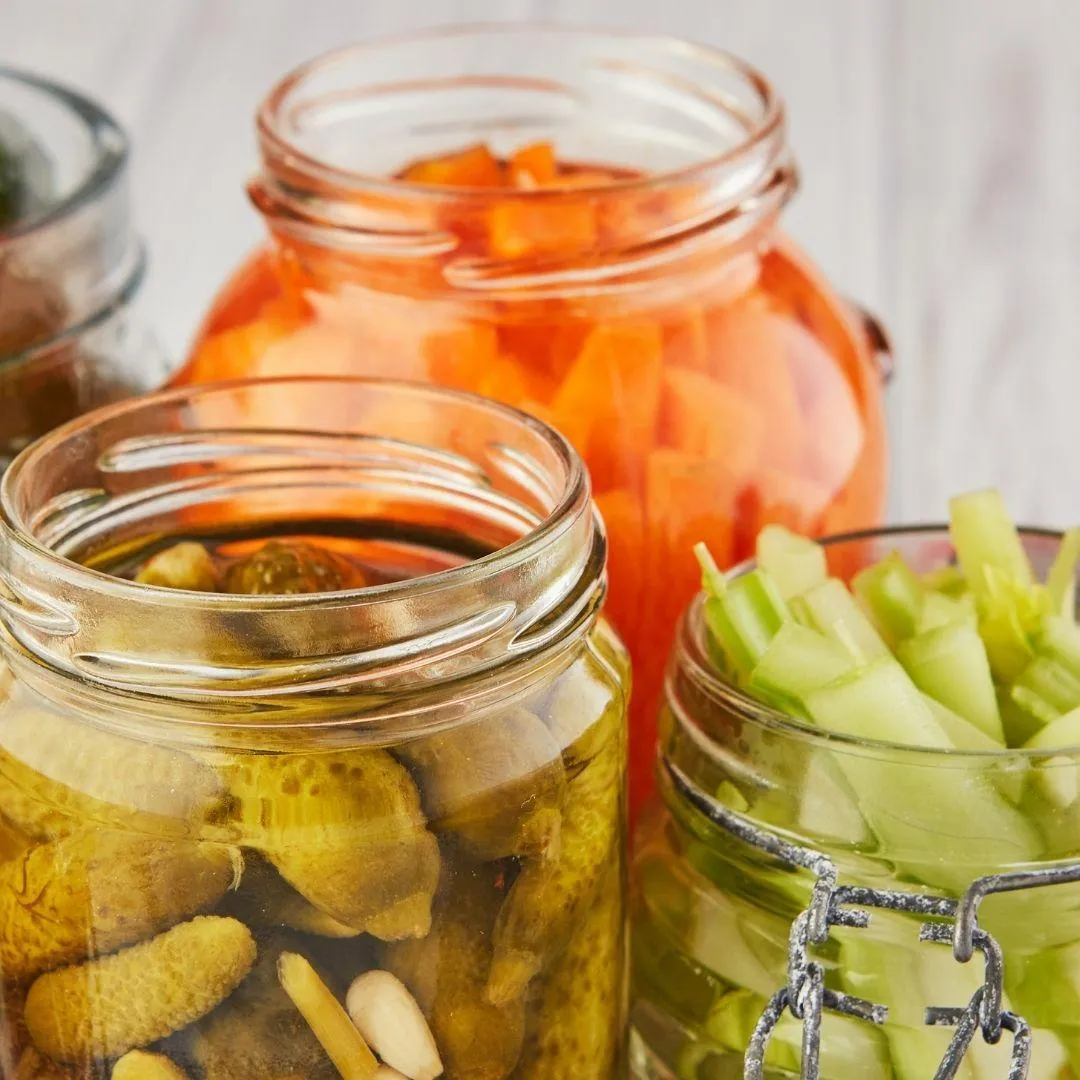
ON THE BLOG

The Symbiotic Relationship of Probiotics and Prebiotics
The Symbiotic Relationship of Probiotics and Prebiotics
If you want to improve your gut health or maintain the good gut health you already have, there are two things you must do. Consume probiotic foods and prebiotics foods and they are best consumed together, creating what is now being called “symbiotic” foods. This is easier than it may sound and can actually be fun.
Probiotic foods contain beneficial organisms that help our gut perform its duties and have amazing health benefits for us. Prebiotics are types of fibre like inulin, resistant starch, GOS and FOS that help feed our good bacteria.
We have two types of bacteria strains in our gut: residential and transient. Residential bacteria strains are the bacteria that live in our gut naturally and we must have them re-populate to stay healthy. Transient strains of bacteria pass through us (usually within 3 days) but while they are there, they help the gut do its work and keep us healthy.
Probiotic foods contain transient bacteria. We need prebiotics to help us feed and increase our residential bacteria.

Getting some prebiotic and probiotic foods on a regular basis is the key and that is quite easy to do. Some examples of probiotic foods are sauerkraut, kimchi, kombucha, yogurt, kefir, miso, natto, pure apple cider vinegar (with mother), true balsamic vinegar, wine, unpasteurized beer, crème fraiche. In order to deliver beneficial organisms from fermented foods to the gut as well as the enzymes these foods also contain, do not heated past a temperature of 118 degrees F (48 C).
Prebiotic foods are Jerusalem Artichokes, chicory, garlic, onions, beans, lentil, citrus fruits, pears, apples, bananas, berries, almonds broccoli which contain soluble fibres like inulin and FOS. Resistant starch found in legumes, potatoes, wheat, corn, rye, barley, rice, spelt, kamut, and other grains and GOS is found in dairy products. The list of foods that are prebiotic is going to expand as research continues to discover more foods containing elements that are probiotic. It could turn out that all whole foods have some prebiotic benefit but we do not know that yet.
Prebiotics are not just food for good bacteria. They also enhance the absorption of calcium and magnesium and are involved in appetite regulation as well as lipid metabolism. As research continues, it is even more fascinating how these simple substances in food, and together with our good bacteria, are involved in a complex relationship to help us be healthy.
Consuming prebiotics with probiotics can be as simple as mixing banana slices into your yogurt or serving sauerkraut with a meal that contains garlic and onions. Maybe this is why we traditionally constructed meals as we did.
What Prebiotics/Probiotics do you consume? Let us know in our community!
References:
1. Inulin-Type Fructans: Functional Food Ingredients1,2 Marcel B. Roberfroid, 2007 American Society for Nutrition
2.Health effects of probiotics and prebiotics A literature review on human studies, Henrik Andersson, Nils-Georg Asp, Åke Bruce, Stefan Roos, Torkel Wadström, Agnes E. Wold, Food and Nutrition Research, Vol 45, 2001
3. Probiotics, prebiotics, and symbiotics: approaches for modulating the microbial ecology of the gut 1,2M David Collins and Glenn R Gibson, 1999 American Society for Clinical Nutrition
4. Lowbush Wild Blueberries have the Potential to Modify Gut Microbiota and Xenobiotic Metabolism in the Rat Colon
5. Alison Lacombe,Robert W. Li,Dorothy Klimis-Zacas,Aleksandra S. Kristo, Shravani Tadepalli,Emily Krauss, Ryan Young,Vivian C. H. Wu mail Published: June 28, 2013 DOI: 10.1371/journal.pone.006749
6. A Systematic Screening of Total Antioxidants in Dietary Plants1, Bente L. Halvorsen et al, Institute for Nutrition Research, Faculty of Medicine, University of Oslo; Akershus University College, Bekkestua, Norway; †Agricultural University of Norway, Ås, Norway; and the ‡Division of Epidemiology, School of Public Health, University of Minnesota
7. Current knowledge of the health benefits and disadvantages of wine consumption, John F. Tomera, Trends in Food Science & Technology – TRENDS FOOD SCI TECHNOL 01/1999; 10(4):129-138. DOI: 10.1016/S0924-2244(99)00035-7

The Symbiotic Relationship of Probiotics and Prebiotics
The Symbiotic Relationship of Probiotics and Prebiotics
If you want to improve your gut health or maintain the good gut health you already have, there are two things you must do. Consume probiotic foods and prebiotics foods and they are best consumed together, creating what is now being called “symbiotic” foods. This is easier than it may sound and can actually be fun.
Probiotic foods contain beneficial organisms that help our gut perform its duties and have amazing health benefits for us. Prebiotics are types of fibre like inulin, resistant starch, GOS and FOS that help feed our good bacteria.
We have two types of bacteria strains in our gut: residential and transient. Residential bacteria strains are the bacteria that live in our gut naturally and we must have them re-populate to stay healthy. Transient strains of bacteria pass through us (usually within 3 days) but while they are there, they help the gut do its work and keep us healthy.
Probiotic foods contain transient bacteria. We need prebiotics to help us feed and increase our residential bacteria.

Getting some prebiotic and probiotic foods on a regular basis is the key and that is quite easy to do. Some examples of probiotic foods are sauerkraut, kimchi, kombucha, yogurt, kefir, miso, natto, pure apple cider vinegar (with mother), true balsamic vinegar, wine, unpasteurized beer, crème fraiche. In order to deliver beneficial organisms from fermented foods to the gut as well as the enzymes these foods also contain, do not heated past a temperature of 118 degrees F (48 C).
Prebiotic foods are Jerusalem Artichokes, chicory, garlic, onions, beans, lentil, citrus fruits, pears, apples, bananas, berries, almonds broccoli which contain soluble fibres like inulin and FOS. Resistant starch found in legumes, potatoes, wheat, corn, rye, barley, rice, spelt, kamut, and other grains and GOS is found in dairy products. The list of foods that are prebiotic is going to expand as research continues to discover more foods containing elements that are probiotic. It could turn out that all whole foods have some prebiotic benefit but we do not know that yet.
Prebiotics are not just food for good bacteria. They also enhance the absorption of calcium and magnesium and are involved in appetite regulation as well as lipid metabolism. As research continues, it is even more fascinating how these simple substances in food, and together with our good bacteria, are involved in a complex relationship to help us be healthy.
Consuming prebiotics with probiotics can be as simple as mixing banana slices into your yogurt or serving sauerkraut with a meal that contains garlic and onions. Maybe this is why we traditionally constructed meals as we did.
What Prebiotics/Probiotics do you consume? Let us know in our community!
References:
1. Inulin-Type Fructans: Functional Food Ingredients1,2 Marcel B. Roberfroid, 2007 American Society for Nutrition
2.Health effects of probiotics and prebiotics A literature review on human studies, Henrik Andersson, Nils-Georg Asp, Åke Bruce, Stefan Roos, Torkel Wadström, Agnes E. Wold, Food and Nutrition Research, Vol 45, 2001
3. Probiotics, prebiotics, and symbiotics: approaches for modulating the microbial ecology of the gut 1,2M David Collins and Glenn R Gibson, 1999 American Society for Clinical Nutrition
4. Lowbush Wild Blueberries have the Potential to Modify Gut Microbiota and Xenobiotic Metabolism in the Rat Colon
5. Alison Lacombe,Robert W. Li,Dorothy Klimis-Zacas,Aleksandra S. Kristo, Shravani Tadepalli,Emily Krauss, Ryan Young,Vivian C. H. Wu mail Published: June 28, 2013 DOI: 10.1371/journal.pone.006749
6. A Systematic Screening of Total Antioxidants in Dietary Plants1, Bente L. Halvorsen et al, Institute for Nutrition Research, Faculty of Medicine, University of Oslo; Akershus University College, Bekkestua, Norway; †Agricultural University of Norway, Ås, Norway; and the ‡Division of Epidemiology, School of Public Health, University of Minnesota
7. Current knowledge of the health benefits and disadvantages of wine consumption, John F. Tomera, Trends in Food Science & Technology – TRENDS FOOD SCI TECHNOL 01/1999; 10(4):129-138. DOI: 10.1016/S0924-2244(99)00035-7
© the wellness equation - a division of 1954080 ontario inc. 2024.
All rights reserved.
